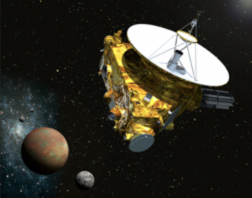 In July 2015, the New Horizons probe will fly past Pluto, snapping pictures and taking data of this icy world. Whether you think Pluto is a planet or not* it’s still a fascinating object and I can’t wait to see what New Horizons sends back.
In July 2015, the New Horizons probe will fly past Pluto, snapping pictures and taking data of this icy world. Whether you think Pluto is a planet or not* it’s still a fascinating object and I can’t wait to see what New Horizons sends back.
But what happens after that? The space probe will still be traveling into deep space at high speed… but space out there isn’t empty. Beyond Pluto lie the solar system’s coldest denizens, the Kuiper Belt Objects. These are lumps of ice, frozen chunks that may take millennia to circle the Sun once. We’ve identified over a thousand of these KBOs, and there are tens of thousands more waiting to be discovered. Scientists with the New Horizons mission are hoping to find one near enough to the probe’s path to plan a flyby, so we can finally see one of these things up close.
And that’s where you come in!
A new website, Ice Hunters, has been put together to help you find potential KBOs for New Horizons to visit. It’s part of the Zooniverse; a citizen science project that gets people involved in real astronomy. In this case, you can examine images from the giant Magellan and Subaru telescopes to look for targets. It’s actually not terribly hard; here’s one image I looked at:
Basically, KBOs move over time, so two images are taken some time apart. One is digitally subtracted from the other, so stars tend to go away (though they don’t erase perfectly, leaving those ugly residuals). Any whitish blobs left are things that have changed between the two images: variable stars, asteroids, cosmic rays, and, hopefully, KBOs. When you find something you simply tag it by clicking it. A circle is placed around it, and the location is logged. You can see the object I found in the image above.
Humans are pretty good at this, while computers are easily confused by the messy residuals. But just to make sure every click is saved and compared to the work of other people. The more an object is clicked, the more likely it is to be something real and worth following up. The website explains how all this works.
That’s all there is to it! You have to register to do this (unless you’re already a Zooniverse member); it’s free and easy. And who knows? You may literally be the person who finds an icy world that will get a visit from New Horizons!
New Horizons image credit: Johns Hopkins University Applied Physics Laboratory/Southwest Research Institute (JHUAPL/SwRI)
*My opinion: defining the word “planet” is a bad bet if not impossible. If you want the longer story, check out this article I wrote for Discover Magazine.
Related posts:
- Hubble spots a chunk of ice 6.7 billion km away
- YOU can find extrasolar planets
- Voorwerp!